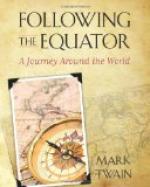The bride was a trim and comely little thing of twelve years, dressed as we would dress a boy, though more expensively than we should do it, of course. She moved about very much at her ease, and stopped and talked with the guests and allowed her wedding jewelry to be examined. It was very fine. Particularly a rope of great diamonds, a lovely thing to look at and handle. It had a great emerald hanging to it.
The bridegroom was not present. He was having betrothal festivities of his own at his father’s house. As I understood it, he and the bride were to entertain company every night and nearly all night for a week or more, then get married, if alive. Both of the children were a little elderly, as brides and grooms go, in India—twelve; they ought to have been married a year or two sooner; still to a, stranger twelve seems quite young enough.
A while after midnight a couple of celebrated and high-priced nautch-girls appeared in the gorgeous place, and danced and sang. With them were men who played upon strange instruments which made uncanny noises of a sort to make one’s flesh creep. One of these instruments was a pipe, and to its music the girls went through a performance which represented snake charming. It seemed a doubtful sort of music to charm anything with, but a native gentleman assured me that snakes like it and will come out of their holes and listen to it with every evidence of refreshment And gratitude. He said that at an entertainment in his grounds once, the pipe brought out half a dozen snakes, and the music had to be stopped before they would be persuaded to go. Nobody wanted their company, for they were bold, familiar, and dangerous; but no one would kill them, of course, for it is sinful for a Hindoo to kill any kind of a creature.
We withdrew from the festivities at two in the morning. Another picture, then—but it has lodged itself in my memory rather as a stage-scene than as a reality. It is of a porch and short flight of steps crowded with dark faces and ghostly-white draperies flooded with the strong glare from the dazzling concentration of illuminations; and midway of the steps one conspicuous figure for accent—a turbaned giant, with a name according to his size: Rao Bahadur Baskirao Balinkanje Pitale, Vakeel to his Highness the Gaikwar of Baroda. Without him the picture would not have been complete; and if his name had been merely Smith, he wouldn’t have answered. Close at hand on house-fronts on both sides of the narrow street were illuminations of a kind commonly employed by the natives —scores of glass tumblers (containing tapers) fastened a few in inches apart all over great latticed frames, forming starry constellations which showed out vividly against their black back grounds. As we drew away into the distance down the dim lanes the illuminations gathered together into a single mass, and glowed out of the enveloping darkness like a sun.




